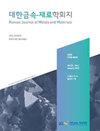sb掺杂SnSe<sub>2</sub>的热电输运性质多晶合金
IF 1.4
4区 材料科学
Q4 MATERIALS SCIENCE, MULTIDISCIPLINARY
引用次数: 0
摘要
SnSe< sub> 2 & lt; / sub>近年来,合金作为势<i>n</i>型热电材料得到了研究。在本研究中,一系列sb掺杂的SnSe<sub>2</sub> Sn(Se<sub>1-x</sub>Sb<sub>x</sub>)<sub>2</sub>(& lt; i> x< / i>= 0,0.015, 0.03, 0.045, 0.06)合金。由于电子浓度的大幅增加,锑的电导率普遍提高。而塞贝克系数随着掺杂的增加而大幅度降低。因此,在低掺杂<i>x</i>= 0.015,然后随着掺杂量的增加而开始上升,超过<i>x</i>= 0.015。结果表明,Sb掺杂使SnSe<sub>2</sub>被掺杂物降解。由于附加的点缺陷散射,总导热系数和点阵导热系数逐渐降低。因此,热电优值显著下降,从低掺杂Sb (<i>x</i>= 0.015)在750 K,到0.18,然后为<i>x</i>= 0.06,逐渐恢复到未掺杂样品的值。随着Sb掺杂量的增加,热电品质因子降低,这意味着Sb掺杂并没有提高热电输运性能,尽管电子浓度大幅增加。本文章由计算机程序翻译,如有差异,请以英文原文为准。
Thermoelectric Transport Properties of Sb-doped SnSe<sub>2</sub> Polycrystalline Alloys
SnSe2 alloys have been investigated in recent times as potential n-type thermoelectric materials. In this study, the thermoelectric transport properties of a series of Sb-doped SnSe2, Sn(Se1-xSbx)2 (x = 0, 0.015, 0.03, 0.045, 0.06) alloys are investigated. The electrical conductivity was generally enhanced with Sb doping owing to a large increase in electron concentration. However, the Seebeck coefficient largely decreased with doping. Consequently, the power factor was significantly lower at a low doping of x = 0.015, and then began rising as the doping was increased beyond x = 0.015. It was found that the density-of-states effective mass and weighted mobility decreased with Sb doping, implying that the electrical transport properties of SnSe2 were degraded by Sb doping. The total and lattice thermal conductivities gradually decreased due to additional point defect scattering. Thus, the thermoelectric figure of merit declined significantly, from 0.30 of the pristine sample with a low doping of Sb (x = 0.015) at 750 K, to 0.18, and then for x = 0.06 it gradually recovered to the value of the undoped sample. The thermoelectric quality factor decreased as the Sb doping was increased, implying that Sb doping did not enhance the thermoelectric transport properties, despite the large increase in electron concentration.
求助全文
通过发布文献求助,成功后即可免费获取论文全文。
去求助
来源期刊

Korean Journal of Metals and Materials
MATERIALS SCIENCE, MULTIDISCIPLINARY-METALLURGY & METALLURGICAL ENGINEERING
CiteScore
1.80
自引率
58.30%
发文量
100
审稿时长
4-8 weeks
期刊介绍:
The Korean Journal of Metals and Materials is a representative Korean-language journal of the Korean Institute of Metals and Materials (KIM); it publishes domestic and foreign academic papers related to metals and materials, in abroad range of fields from metals and materials to nano-materials, biomaterials, functional materials, energy materials, and new materials, and its official ISO designation is Korean J. Met. Mater.
 求助内容:
求助内容: 应助结果提醒方式:
应助结果提醒方式:


